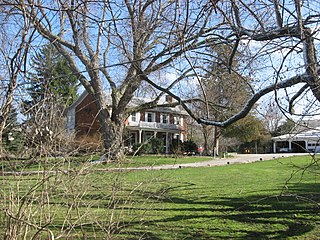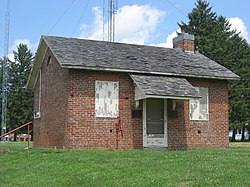
Darke County is a county in the U.S. state of Ohio. As of the 2010 census, the population was 52,959. Its county seat is Greenville. The county was created in 1809 and later organized in 1817. It is named for William Darke, an officer in the American Revolutionary War. Darke County comprises the Greenville, OH Micropolitan Statistical Area, which is also included in the Dayton-Springfield-Sidney, OH Combined Statistical Area.

Adams Township is one of the twenty townships of Darke County, Ohio, United States. The 2010 census found 3,441 people in the township, 2,163 of whom lived in the unincorporated portions of the township.

The Darke County Courthouse, Sheriff's House and Jail are three historic buildings located at 504 South Broadway just south of West 4th Street in Greenville, Ohio. On December 12, 1976, the three buildings of the present courthouse complex were added to the National Register of Historic Places.

The Martin Marmon House is a historic house near the village of Zanesfield in Jefferson Township, Logan County, Ohio, United States. Built by pioneer settler Martin Marmon around the year 1820, it is one of the best remaining examples of Quaker architecture in the area.

Holy Family Catholic Church is a historic Roman Catholic church in Wayne Township, Darke County, Ohio, United States. Located in the unincorporated community of Frenchtown, it houses an active congregation, and it has been accorded historic site status because of its well-preserved Gothic Revival architecture.

Frenchtown is an unincorporated community in Wayne Township, Darke County, Ohio, United States. The community lies at the intersection of State Route 185 with Burns and Mangen Roads, approximately 2 miles (3.2 km) northwest of the village of Versailles. Its elevation is 1,027 feet (313 m).

St. Remy's Catholic Church is a historic Roman Catholic church in Russia, Ohio, United States. Built in 1890, it continues to house an active parish, and it has been recognized as a historic site because of its architecture.

St. Michael's Catholic Church is a historic Catholic church in Mechanicsburg, a village in Champaign County, Ohio, United States. Completed in the 1880s, it served a group of Catholics who had already been meeting together for nearly thirty years. One of several historic churches in the village, it has been designated a historic site because of its well-preserved nineteenth-century architecture.

St. Nicholas Catholic Church is a historic Roman Catholic church in Osgood, Ohio, United States. Built in the first years of the 20th century, it houses one of the newest parishes in a heavily Catholic region of far western Ohio, but it has been recognized as a historic site for its architecture.

Fort Jefferson was a fortification erected by soldiers of the United States Army in Oct. 1791 during the Northwest Indian War. Built to support a military campaign, it saw several years of active fighting. Today, the fort site is a historic site.

The Benjamin Franklin Coppess House, built in 1882, is a historic Queen Anne and Stick-Eastlake style house located at 209 Washington Street in Greenville, Ohio, United States.

The Donovan Robeson House is a historic house in Greenville, Ohio, United States. Located along Fourth Street west of downtown, the Robeson House has been ranked as the city's most significant Queen Anne mansion.

The Christopher C. Walker House and Farm is a historic farmstead in the far western part of the U.S. state of Ohio. Located southwest of the village of New Madison along State Route 121, it is composed of five buildings and one other structure spread out over an area of nearly 160 acres (65 ha).

The Goll Homestead is a historic farm complex in far western Fulton County, Ohio, United States. Located in German Township northwest of Archbold, the farm has been declared a historic site because of its role in the region's settlement.

Bear's Mill is a historic gristmill near the city of Greenville in Darke County, Ohio, United States. Built in 1849, this watermill is the oldest existing industrial building in Darke County. Built by Manning Hart, a local contractor, the mill lies along Greenville Creek in southwestern Adams Township, midway between Greenville and the village of Gettysburg. It was purchased before its completion by Pennsylvanian Gabriel Bear, who completed and opened the mill in 1849. After his locally made millstones proved faulty, Bear travelled to France, where he acquired stones of a type regarded worldwide as of highest quality.

The Greenville Mausoleum is an imposing Egyptian Revival structure in Greenville, Ohio, United States. Built in 1913, this historic mausoleum is built of concrete covered with courses of limestone, resting on a foundation of granite and covered with a roof of ceramic tiles. Among its most distinctive elements are the marble pillars, topped with capitals of the Doric order, that line the main entrance. The main portion of the interior, built in a basilican style with multiple aisles, contains approximately four hundred concrete and marble crypts, and the building's wings house individual family crypts. It is lit by twelve clerestory windows under the roofline.

The Griffith Breese Farm is a historic farmstead in southern Allen County, Ohio, United States. Established in 1840, the farm is one of the oldest white settlements in a formerly Native American area of northwestern Ohio, and it has been designated a historic site because of its unusually good degree of preservation.

St. Henry's Catholic Church is a historic Catholic parish in the rural community of Harriettsville in the southeastern part of the U.S. state of Ohio. Established for German settlers in the 1860s, it worships in a landmark church building constructed in the 1890s. As the only stone building in the area and the work of a prominent architect, it has been named a historic site.

The Berryhill-Morris House is a historic farmhouse near the city of Bellbrook in Greene County, Ohio, United States. Built in the 1830s for an elderly veteran, it has changed little since its early years, and it has been named a historic site.

The Michaels Farm is a historic homestead in the northwestern part of the U.S. state of Ohio. Composed of simple vernacular structures and buildings with clear architectural stylistic influences, the farm has been home to members of the same families for nearly two hundred years, and it has been named a historic site.





















